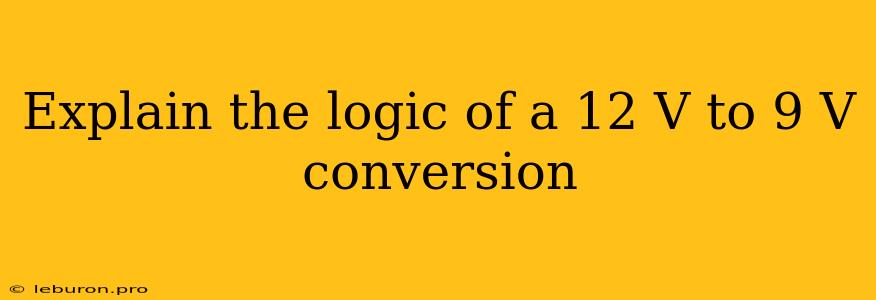Converting a 12V DC power supply to a 9V DC power supply is a common requirement in various electronic projects and applications. This conversion is often necessary when a device requires a lower voltage than what is readily available. The logic behind this conversion involves reducing the voltage while maintaining the desired current level. This process can be achieved using different methods, each with its own advantages and disadvantages. Understanding the underlying principles of these methods helps in choosing the most suitable approach for specific applications.
Understanding the Basics of Voltage Conversion
At its core, voltage conversion aims to alter the electrical potential difference between two points in a circuit. To convert 12V to 9V, we essentially need to reduce this potential difference by 3V. This reduction can be accomplished by various techniques, such as using a voltage divider, a linear voltage regulator, or a switching regulator.
Voltage Divider
The voltage divider method is the simplest approach to voltage conversion. It utilizes two resistors connected in series to create a potential difference across the desired point. The output voltage is determined by the ratio of the resistors.
Figure 1: Voltage Divider
!
In Figure 1, the output voltage (Vout) is calculated as follows:
Vout = (R2 / (R1 + R2)) * Vin
Where:
- Vin is the input voltage (12V)
- R1 and R2 are the resistor values.
By carefully selecting the resistor values, we can achieve the desired 9V output. However, the voltage divider has its limitations.
- Inefficient power usage: The voltage divider dissipates power as heat in the resistors, making it less efficient for high-power applications.
- Load dependency: The output voltage varies with the load connected to the divider. This can be problematic in circuits where the load changes frequently.
Linear Voltage Regulator
Linear voltage regulators provide a more stable and regulated output voltage compared to voltage dividers. These regulators operate by dropping the excess voltage across themselves, acting as a variable resistor.
Figure 2: Linear Voltage Regulator
!
In Figure 2, the linear voltage regulator maintains a constant output voltage (Vout) by adjusting its internal resistance. Any excess voltage above 9V is dissipated as heat.
Linear regulators offer several advantages:
- Low noise and ripple: They produce a clean and stable output voltage with minimal noise and ripple.
- Easy to use: They are readily available in various configurations and are relatively simple to implement.
However, linear regulators also have limitations:
- Efficiency: They are less efficient than switching regulators as they dissipate the excess voltage as heat.
- Limited current capacity: Their current handling capacity can be limited, especially for high-power applications.
Switching Regulator
Switching regulators utilize a switching element, such as a transistor or MOSFET, to rapidly switch the input voltage on and off. This creates a pulse-width modulated (PWM) signal that can be averaged to produce the desired output voltage.
Figure 3: Switching Regulator
!
In Figure 3, the switching regulator operates in a closed loop, continuously adjusting the duty cycle of the PWM signal to maintain a constant output voltage.
Switching regulators are highly efficient due to their ability to minimize power loss. They also offer:
- Higher current capacity: They can handle significantly higher current levels compared to linear regulators.
- Improved regulation: They can provide precise voltage regulation over a wide range of input and output conditions.
However, switching regulators have their own drawbacks:
- Higher complexity: They require more complex circuitry and control systems.
- Potential noise generation: The switching process can generate noise, which may need to be filtered.
Choosing the Right Approach
The choice of method for converting 12V to 9V depends on the specific requirements of the application. For simple applications with low power demands, a voltage divider may suffice. However, if a more stable and regulated output is desired, a linear voltage regulator is preferred. For high-power applications, switching regulators offer the highest efficiency and current handling capabilities.
Practical Considerations
- Power requirements: Determine the power required by the device or circuit. This will influence the choice of voltage regulator and its current capacity.
- Output voltage accuracy: Consider the tolerance required for the output voltage.
- Noise sensitivity: Assess the sensitivity of the load to noise and ripple.
- Cost: The cost of different conversion methods can vary significantly.
Conclusion
Converting 12V to 9V involves reducing the voltage while maintaining the desired current level. The methods used for this conversion include voltage dividers, linear voltage regulators, and switching regulators. Each approach has its advantages and disadvantages. The selection of the most suitable method depends on factors such as power requirements, output voltage accuracy, noise sensitivity, and cost. By understanding the underlying principles and choosing the appropriate method, you can effectively convert 12V to 9V for a wide range of electronic applications.
